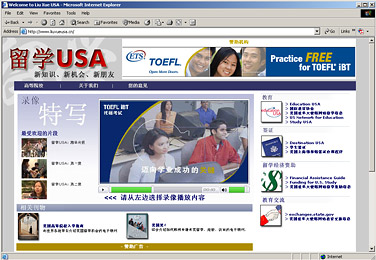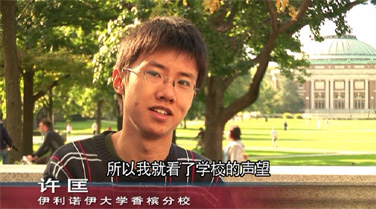|
|
|
||||||||||
|
Electronic Education Fair Promotes United States as Higher Education Destination to Chinese Students A multimedia campaign launched in China in November marks the first step in a U.S. government initiative designed to promote travel to the United States to pursue higher education opportunities. by Alex FeldmanThe Department of Commerce, in partnership with the Department of State, has embarked on an innovative campaign to promote U.S. higher education opportunities to students in China. On November 15, 2006, during his trade mission to China, Secretary of Commerce Carlos M. Gutierrez announced the initiative in a speech to the Shanghai American Chamber of Commerce. (Story continues below.)
“We want Chinese students to know that America welcomes them,” said Gutierrez. “Our universities are great launching pads for [their] careers. … This is a testament to the strong bond between our nations and the importance we place on educating our young people to participate in the global marketplace.” Response to University Presidents’ Summit The China campaign is an outcome of the University Presidents’ Summit on International Education, which was held in Washington, D.C., on January 5–6, 2006. The summit, which was cohosted by Secretary of State Condoleezza Rice and Secretary of Education Margaret Spellings, brought together leading government officials and 121 university presidents. It focused on strengthening international education at U.S. universities, creating more opportunities for U.S. students to study abroad, and attracting foreign students and faculty to the United States. At the conclusion of the summit, university presidents emphasized a desire for the U.S. government to take a more active role in promoting American higher education throughout the world. Multimedia Approach The education campaign is officially known as the Electronic Education Fair for China or, in Chinese, as Liu Xue USA (“Study Abroad USA”). It takes a multimedia approach to promoting education opportunities in the United States, and it will reach more than 180 million people in China by using television, the Internet, and on-ground activities. Those activities include the following:
(Story continues below.)
The television programming features interviews with Chinese students who talk about their experiences with studying in the United States. Filming took place at 13 U.S. colleges and universities. An Important Service Export Education services is one of the top services export categories in the United States, earning slightly more than $14 billion in 2005 according to the Commerce Department’s Bureau of Economic Analysis. In 2004–05, according to a study published by the Institute of International Education, an estimated 565,039 international students were enrolled in U.S. institutions of higher education. Of that number, 62,523 were Chinese nationals. China has 630 million people under the age of 24, one of the largest student populations in the world. The campaign will measure its success in penetrating the Chinese market by a variety of means, including tracking numbers of visitors to the Web page, of students taking admissions tests, and of students matriculated at U.S. colleges and universities. Partnership with the Private Sector The education community and the U.S. Departments of State and Commerce jointly funded the initiative. The private education community, including a major gift from Educational Testing Service’s TOEFL (Test of English as a Foreign Language) division, generated approximately 40 percent of the budget. Alex Feldman is a senior advisor to the under secretary for international trade.
|
|

